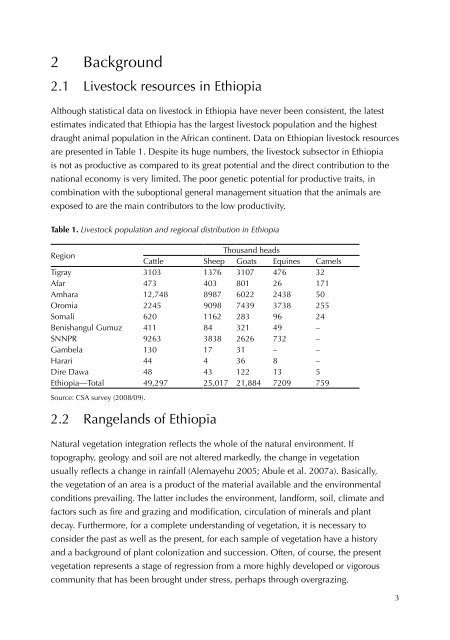Rangeland condition and feed resources in Metema District, North ...
Rangeland condition and feed resources in Metema District, North ...
Rangeland condition and feed resources in Metema District, North ...
You also want an ePaper? Increase the reach of your titles
YUMPU automatically turns print PDFs into web optimized ePapers that Google loves.
2 Background<br />
2.1 Livestock <strong>resources</strong> <strong>in</strong> Ethiopia<br />
Although statistical data on livestock <strong>in</strong> Ethiopia have never been consistent, the latest<br />
estimates <strong>in</strong>dicated that Ethiopia has the largest livestock population <strong>and</strong> the highest<br />
draught animal population <strong>in</strong> the African cont<strong>in</strong>ent. Data on Ethiopian livestock <strong>resources</strong><br />
are presented <strong>in</strong> Table 1. Despite its huge numbers, the livestock subsector <strong>in</strong> Ethiopia<br />
is not as productive as compared to its great potential <strong>and</strong> the direct contribution to the<br />
national economy is very limited. The poor genetic potential for productive traits, <strong>in</strong><br />
comb<strong>in</strong>ation with the suboptional general management situation that the animals are<br />
exposed to are the ma<strong>in</strong> contributors to the low productivity.<br />
Table 1. Livestock population <strong>and</strong> regional distribution <strong>in</strong> Ethiopia<br />
Region<br />
Thous<strong>and</strong> heads<br />
Cattle Sheep Goats Equ<strong>in</strong>es Camels<br />
Tigray 3103 1376 3107 476 32<br />
Afar 473 403 801 26 171<br />
Amhara 12,748 8987 6022 2438 50<br />
Oromia 2245 9098 7439 3738 255<br />
Somali 620 1162 283 96 24<br />
Benishangul Gumuz 411 84 321 49 –<br />
SNNPR 9263 3838 2626 732 –<br />
Gambela 130 17 31 – –<br />
Harari 44 4 36 8 –<br />
Dire Dawa 48 43 122 13 5<br />
Ethiopia—Total 49,297 25,017 21,884 7209 759<br />
Source: CSA survey (2008/09).<br />
2.2 <strong>Rangel<strong>and</strong></strong>s of Ethiopia<br />
Natural vegetation <strong>in</strong>tegration reflects the whole of the natural environment. If<br />
topography, geology <strong>and</strong> soil are not altered markedly, the change <strong>in</strong> vegetation<br />
usually reflects a change <strong>in</strong> ra<strong>in</strong>fall (Alemayehu 2005; Abule et al. 2007a). Basically,<br />
the vegetation of an area is a product of the material available <strong>and</strong> the environmental<br />
<strong>condition</strong>s prevail<strong>in</strong>g. The latter <strong>in</strong>cludes the environment, l<strong>and</strong>form, soil, climate <strong>and</strong><br />
factors such as fire <strong>and</strong> graz<strong>in</strong>g <strong>and</strong> modification, circulation of m<strong>in</strong>erals <strong>and</strong> plant<br />
decay. Furthermore, for a complete underst<strong>and</strong><strong>in</strong>g of vegetation, it is necessary to<br />
consider the past as well as the present, for each sample of vegetation have a history<br />
<strong>and</strong> a background of plant colonization <strong>and</strong> succession. Often, of course, the present<br />
vegetation represents a stage of regression from a more highly developed or vigorous<br />
community that has been brought under stress, perhaps through overgraz<strong>in</strong>g.<br />
3

















